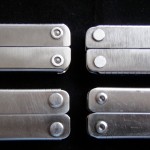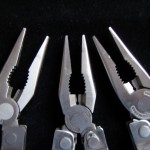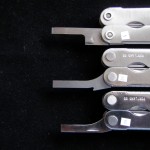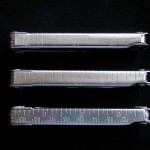| Known Changes |
 BladeShape BladeShape
We know that the earliest PSTs featured a drop point blade (top) that was somewhat crude by comparison to the later “saber” (middle) and clip point blades (bottom). |
 Fasteners Fasteners
US made PSTs were held together using proprietary “knurled” screws, whilst those subcontracted to Mitsubohi Cutlery in Japan used rivets. Although unusual, some fasteners (screws and rivets) appear to be drilled, or “hollow” |
 Can Opener Can Opener
Very early Can Openers were constructed with the angled cutting edge visible on the left side that also incorporates the nail-nick, whereas later models have the cutting edge on the right side. |
 File File
On earlier models the file was “double cut” (i.e. grooves ran diagonally in both directions, creating a diamond pattern) on both sides. Later models however have only one side double cut, and the other single cut (i.e. parallel lines). |
 Hard Wire Notch Hard Wire Notch
Early PSTs do not have a hard wire notch, intended to lengthen the useful life of the cutters within the plier head. Eventually a subtle arrow was including in the plier castings to point to the notch. |
 Plier Pivot Markings Plier Pivot Markings
Initially, the Plier head pivot bore only the Leatherman name on the pivot, until “USA” was added years later. Following the Californian court action however, the “USA” was dropped in favour of “TOOL”. During this period, it is possible that plier heads stocks were high, and I have observed one PST where the USA has been milled out, presumably to allow the use of that plier head without incurring any further legal challenges. |
 Medium Flat Screwdriver Medium Flat Screwdriver
There are three distinct styles of medium screwdriver used throughout the PST’s life. Starting with the square “pivot out” design (top), the driver evolved to a more sculpted design (bottom), before a top nail nick was added to aid opening in the later models (centre). |
 Ruler Markings Ruler Markings
Initially, the handle ruler markings only showed imperial (inches) gradients, however later models include metric (centimetres) too. This may have been a refelection of the tool’s increasing popularity outside of the USA. |
One Response